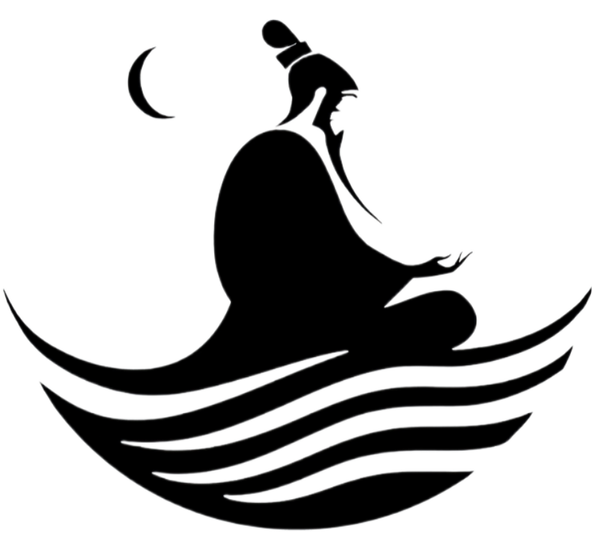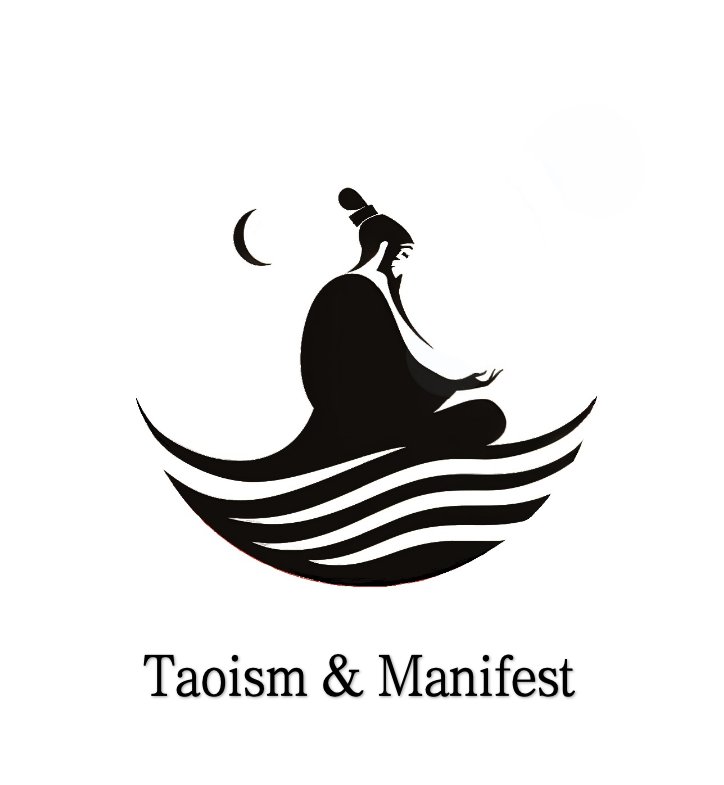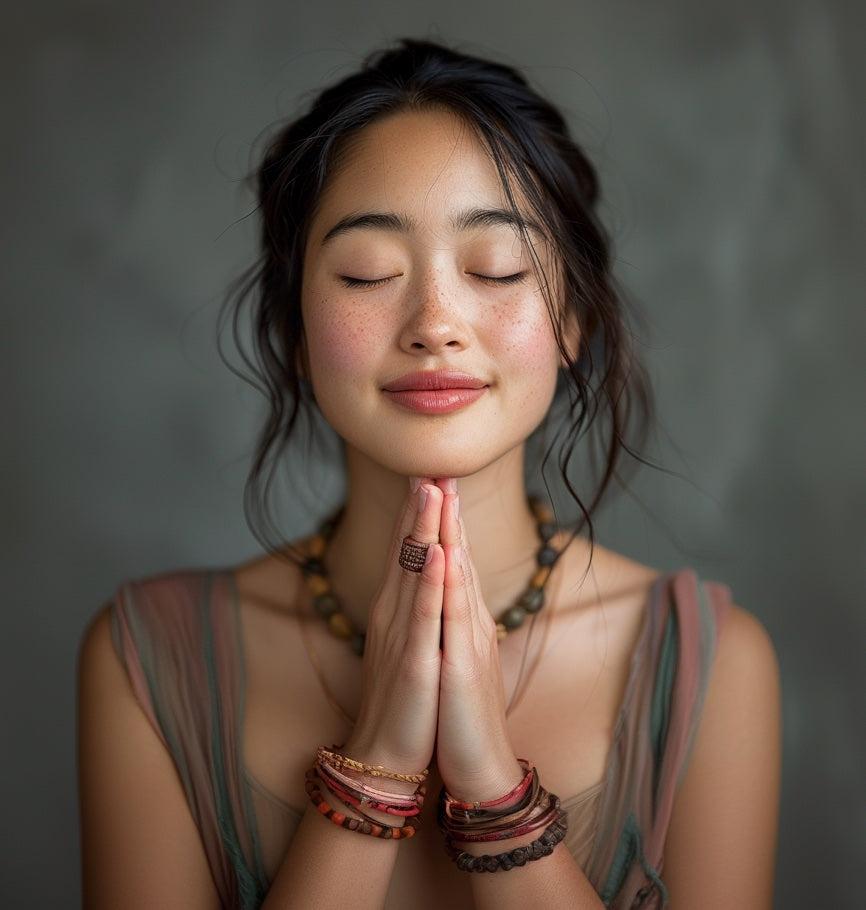
Feeling too much stress or anxiety is common for many people. The World Health Organization says about 4% of people in the world have anxiety disorders. This means you are not alone. Taoism teaches a soft mindset to help you accept these feelings gently. Many people say that mindfulness, tai chi, and other Taoist ways make life less stressful. If you feel too much anxiety, you can start to feel calm with easy steps. Tai chi and mindfulness do not need special skills. You can learn to calm your mind and body. Tai chi helps you move slowly and breathe deeply. Let’s see how you can use these ideas every day, even when you feel a lot of anxiety.
Key Takeaways
Taoism teaches you to have a soft mindset. This helps you accept anxiety in a gentle way. You do not have to fight it. This brings more calm and peace to your life.
You can use simple things like mindful breathing, tai chi, and meditation. These can lower stress. They help your mind and body relax.
If you follow the natural flow of life, called Wu Wei, you let go of control. You move with changes. This helps you handle anxiety better.
Balancing activity and rest is important. Being in nature also helps your mental health. These things help you feel more peaceful.
You can use easy and quick steps when you feel anxious. Pause, breathe, notice your feelings, accept them, and go with the moment.
Taoism and Anxiety
Soft Mindset Explained
Taoism teaches you that anxiety is not a flaw. You experience anxiety when you feel out of harmony with the present moment or the natural flow of life. Taoist teachings say that living in the future brings anxiety, while living in the past brings sadness. When you focus on the present, you find peace. This idea comes from Lao Tzu, a famous Taoist teacher.
You can see the difference between Taoism and Western ideas about anxiety:
Taoism sees anxiety as a sign that you are not in tune with the Tao, or the natural way of things.
Taoist teachings encourage you to accept your feelings and let them pass, instead of fighting them.
Western approaches often tell you to solve problems and control your feelings.
Taoism suggests that less striving and more acceptance bring calm.
Taoist mindfulness helps you notice your thoughts and feelings without judging them. You learn to accept change and flow with life. This soft mindset values patience, kindness, and balance. Taoist teachings use the five elements—fire, earth, water, wood, and metal—to show how your emotions connect to nature. When you balance these elements, you support your mental health and emotional well-being.
Tip: When you feel anxious, remind yourself that change is natural. You can let your feelings come and go, just like clouds in the sky.
Wu Wei and Letting Go
Wu Wei is a key part of Taoist teachings. It means "effortless action." You act in harmony with the Tao, instead of forcing things. Wu Wei helps you let go of control and perfectionism. When you practice Wu Wei, you allow change to happen without resistance. This makes stress and anxiety easier to handle.
Scientific studies show that Wu Wei can help your brain work better. People who use Wu Wei have stronger connections between different parts of the brain. Teams that follow Wu Wei make fewer mistakes and feel less stress. You also feel more satisfied with your choices and have less regret. Wu Wei encourages you to accept change and stay flexible. This helps you manage anxiety and stress in daily life.
Taoist mindfulness and Wu Wei both teach you to flow with change. You do not need to fight every challenge. Instead, you can move like water, gentle but strong. Letting go and non-resistance help you save energy and feel more at peace. Studies in China show that Taoist therapy based on these ideas can reduce anxiety symptoms. When you accept change and let go, you build emotional strength and resilience.
Remember: You do not need to control everything. Trust the Tao and let life unfold. Change is part of the journey, and you can meet it with softness and ease.
Taoist Principles for Stress Reduction
Yin-Yang Balance
Taoism teaches you that everything in life has two sides. These sides are called Yin and Yang. Yin means quiet, cool, and soft. Yang means active, warm, and strong. Taoist teachings say that you need both Yin and Yang to feel well. When you balance these two, you help your body and mind work together. If you feel too much stress, you might have too much Yang. If you feel tired or sad, you might have too much Yin. Taoist teachings show you how to notice these changes and bring them back into balance. This balance helps reduce stress and supports your mental health. You can find more peace and well-being when you keep Yin and Yang in harmony.
Simplicity and Flow
Taoist teachings value simplicity. You do not need to fill your life with too many things or thoughts. Taoism says that when you keep life simple, you feel lighter and happier. Wu Wei, or effortless action, helps you rest when you need to. Pu, the uncarved block, reminds you to stay true to yourself. Ziran, living with nature, helps you follow the natural flow of life. These Taoist teachings guide you to let go of extra worries and reduce stress. When you follow the flow, you accept change and do not fight against it. This brings more peace and inner peace to your daily life.
Tip: Try to notice when you feel rushed or overloaded. Take a moment to breathe and let go of what you do not need. This simple act can help you reduce stress and feel more at peace.
Taoist Virtues
Taoist teachings encourage you to practice virtues like humility and compassion. Humility means you accept yourself, even when you make mistakes. You do not need to be perfect. Compassion means you are kind to yourself and others. These Taoist teachings help you build emotional strength. When you face change, you can stay calm and open. You learn to trust the Tao and let go of fear. This helps you find inner peace and well-being. Taoist teachings show you that every change is a chance to grow. You can meet each day with patience and peace.
Three-Step Practice for Anxiety
When anxiety visits, you can use a simple Taoist practice to help yourself feel calm. This three-step method—awareness, acceptance, and following the flow—comes from Taoism and modern mindfulness. Each step helps you face change and find peace in the moment.
Awareness
Start by noticing what is happening inside you. Take a slow breath. Ask yourself, “What am I feeling right now?” You might feel your heart beating faster or your thoughts racing. Do not try to push these feelings away. Just notice them. This is awareness.
Research shows that when you pay attention to your feelings, you gain more control over anxiety. You learn to see anxiety as a signal, not a problem. Present-moment awareness helps you respond to change with calm. You become more confident in handling stress. You also stop avoiding your feelings, which makes anxiety smaller over time.
Tip: When you feel anxious, pause and name what you notice. Say to yourself, “I feel nervous,” or “My chest feels tight.” This simple act brings you back to the present.
Acceptance
After you notice your feelings, the next step is acceptance. Acceptance means you allow your feelings to be there, even if they are uncomfortable. You do not need to like anxiety, but you do not fight it. You let it come and go, just like the weather.
Studies show that acceptance helps people of all ages feel less anxious. Therapies that teach acceptance, like ACT, help you handle change and stress better. When you accept your feelings, you stop wasting energy on fighting them. You become more flexible and open to change. This makes anxiety feel less scary. You need to know that acceptance does not mean giving up. It means you trust that change will happen, and you can handle it.
Following the Flow
The last step is following the flow, or 顺势而为 in Taoism. This means you move with change, not against it. Imagine a river. When you swim with the current, you use less energy. When you fight the current, you get tired and stressed.
Taoism teaches you to trust the natural flow of life. You do not need to control every change. Instead, you adapt and move gently with what happens. Mindfulness-based therapy supports this idea. When you follow the flow, you let go of old habits that make anxiety worse. You learn to welcome change as part of life.
Try this: When you notice anxiety, ask yourself, “Can I go with this feeling instead of fighting it?” Picture yourself floating on water, letting change carry you forward.
How to Use the Three Steps
You can use this practice anytime anxiety appears. Here is a quick guide:
Pause and notice what you feel (awareness).
Allow your feelings to be there (acceptance).
Move with the moment and trust the process (following the flow).
You do not need to be perfect. Each time you practice, you build strength and peace. Taoism reminds you that change is always happening. When you meet change with awareness, acceptance, and flow, you find calm in the middle of anxiety.
Breathing Techniques for Stress
Taoist Breathing Basics
You can use mindful breathing to reduce stress and bring calm to your day. Taoist breathing techniques focus on slow, deep breaths that fill your lower belly. This style of breathing helps you relax your body and mind. When you practice mindful breathing, you send a signal to your brain that it is safe to relax. Scientific studies show that these breathing techniques can improve your mood, boost your energy, and help you feel more peaceful. You may notice your heart rate slows down and your thoughts become clearer. Taoist breathing also helps your body by increasing oxygen and improving blood flow. Many people say they feel more balanced and less anxious after just a few minutes of mindful breathing.
Step-by-Step Practice
You can start Taoist breathing with a simple step-by-step practice. First, sit comfortably and place your hands on your lower belly. Breathe in slowly through your nose, letting your belly rise. Try to keep your chest still. Next, breathe out gently through your mouth, feeling your belly fall. Focus on the feeling of your breath moving in and out. Repeat this for several breaths. If your mind wanders, gently bring your attention back to your breathing. This mindful breathing practice helps reduce stress and anxiety. Unlike some other breathing techniques, Taoist breathing encourages you to imagine energy moving through your body. You may feel warmth or tingling as you breathe. This practice can help you feel calm, focused, and ready for the day.
Micro-Meditation Pauses
You do not need a lot of time to reduce stress. Micro-meditation pauses use mindful breathing for just 30 seconds to a few minutes. These short breaks can help you reset your mind and body. Research shows that even a quick pause with mindful breathing can lower your heart rate and calm your nerves. You can try a micro-meditation by closing your eyes, taking three slow breaths, and noticing how your body feels. These small moments of mindful breathing can make a big difference in your mood and focus. Over time, regular micro-meditation pauses help you manage stress and feel more at ease throughout your day.
Taoist Meditation and Visualization
Calming the Mind
Taoist meditation can help you feel calm in your mind and body. When you meditate, you slow down and notice your thoughts. You do not judge your thoughts. Sitting quietly and focusing on your breath gives your mind a break. Many people say meditation helps lower stress and anxiety. Even a few minutes can make you feel more peaceful.
Scientists found that Taoist meditation boosts alpha and theta brain waves. These brain waves help you feel relaxed but also alert. Your heart may beat slower, and your body feels calm. This helps you deal with stress better. Taoist meditation, like Inner Stillness Meditation and gentle breathing, leads you to inner peace. You learn to let go of worries and find quiet inside yourself.
Tip: Sit somewhere comfortable, close your eyes, and breathe slowly and deeply. Pay attention to each breath as it goes in and out. Let your thoughts float by like clouds.
Visualization for Balance
Visualization is a Taoist practice that helps you feel balanced and calm. You picture peaceful places or imagine energy moving in your body. Visualization works with meditation and breathing to help you feel centered. Studies show that visualization helps your mind focus and your body relax. This balance brings emotional stability.
Taoist teachings say visualization can change your inner energy. You might imagine light filling your body or see yourself floating on a calm river. These pictures help you let go of tension and feel peaceful. When you use visualization with slow breathing, you support your emotional health. You feel calmer, more focused, and ready for challenges.
Note: You can use visualization whenever you need to feel calm. Imagine a safe, peaceful place. Let this picture fill your mind as you breathe deeply.
Gentle Movement: Tai Chi & Qigong
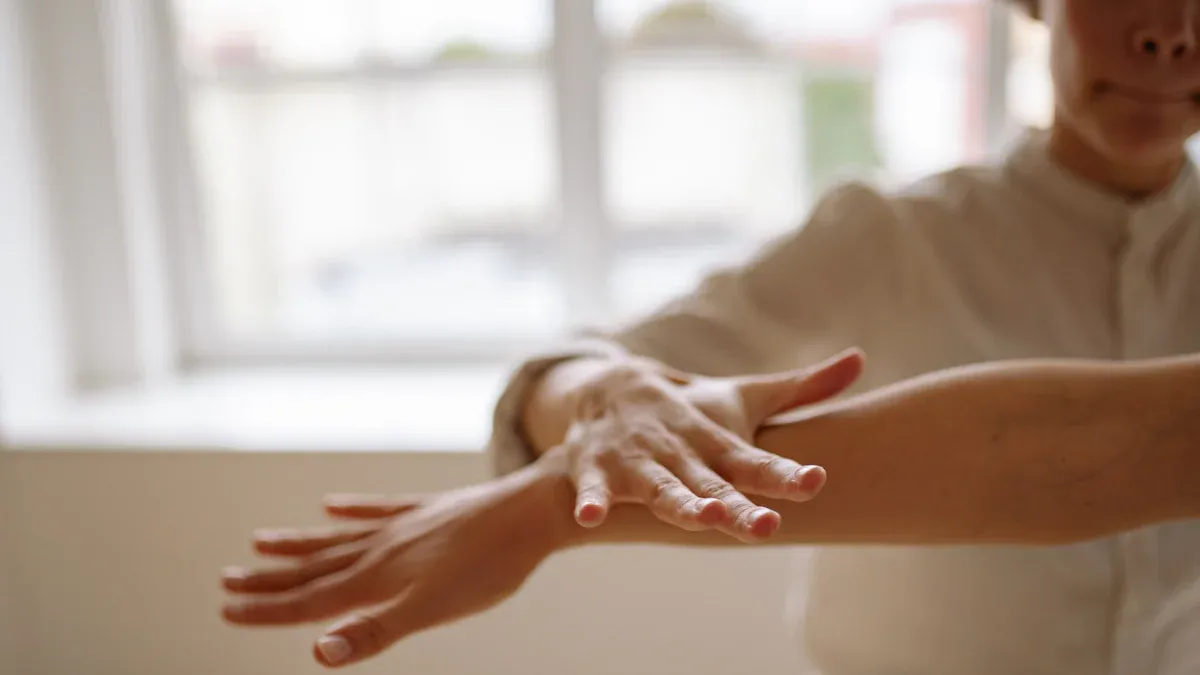
Benefits for Anxiety
You can use gentle movement to help your mind and body feel calm. Tai chi and qigong are two ancient practices from China. People have used them for hundreds of years to support health and peace of mind. When you try tai chi, you move slowly and breathe deeply. Qigong uses smooth motions and focused breathing. Both help you relax and let go of tension.
Many studies show that tai chi and qigong can lower anxiety and stress. Some research even finds that qigong works as well as talk therapy for some people. Tai chi helps people with heart problems, older adults, and even healthy people feel less anxious and sad. Scientists believe these practices help your body by changing how your genes react to stress. They also help your brain and body work together better.
When you practice tai chi or qigong, you give your mind a break from worry. You learn to focus on your breath and your movements. This helps you feel more balanced and peaceful.
Simple Movements
You do not need to learn a long routine to start tai chi movement practice. Simple forms like Yang-8 or Yang-24 are easy to follow. These forms use gentle steps, slow arm circles, and upright posture. You can practice tai chi movement practice in a small space, even at home.
Here are some easy movements you can try:
Stand tall and relax your shoulders.
Slowly lift your arms as you breathe in.
Lower your arms as you breathe out.
Shift your weight from one foot to the other in a gentle, flowing motion.
Move your hands in circles, like you are holding a ball of energy.
Qigong sets like Baduanjin also use simple, repeated movements. These help you stretch, breathe, and focus your mind. You do not need special equipment or clothes. Just wear something comfortable and move at your own pace.
Remember, the goal is not to be perfect. Each time you practice tai chi or qigong, you help your body and mind feel calmer. Even a few minutes can make a difference in your day.
Daily Mindfulness Practice
Being Present
You can bring more calm into your life by being present. Taoist mindfulness teaches you to notice what is happening right now. When you focus on the present, you let go of worries about the past or future. This simple act helps your mind and body relax. Many people find that daily mindfulness practice leads to sudden moments of peace. You might feel your jaw unclench or your breathing slow down. These small changes show that your body is letting go of stress.
Taoist mindfulness uses the idea of Wu Wei, or effortless action. You learn to act naturally, without forcing things. You pay attention to your breath and your body. You notice tension and let it go. This practice helps you stay grounded and calm, even when life feels busy. By practicing mindfulness every day, you build emotional strength and support your mental health.
Focus on your breath to stay present.
Notice how your body feels.
Accept your thoughts without judgment.
Let go of the need to control every moment.
Everyday Mindfulness
You can practice Taoist mindfulness in many parts of your day. Try to bring awareness to simple tasks, like eating breakfast or walking outside. When you wash your hands, feel the water and notice the movement. These small moments of daily mindfulness help you stay calm and balanced.
Practicing mindfulness does not need to take a lot of time. Even a few minutes of meditation or deep breathing can make a big difference. Scientific studies show that daily mindfulness lowers stress hormones and helps your body respond better to challenges. You may sleep better and feel more at ease. Over time, these habits improve your well-being and support your mental health.
Taoist mindfulness encourages you to listen to your body and follow the natural flow of life. You learn to balance work and rest. You also connect more deeply with others by listening and being present. Each day, you can choose to practice mindfulness and enjoy greater calm and well-being.
Grounding and Nature Connection
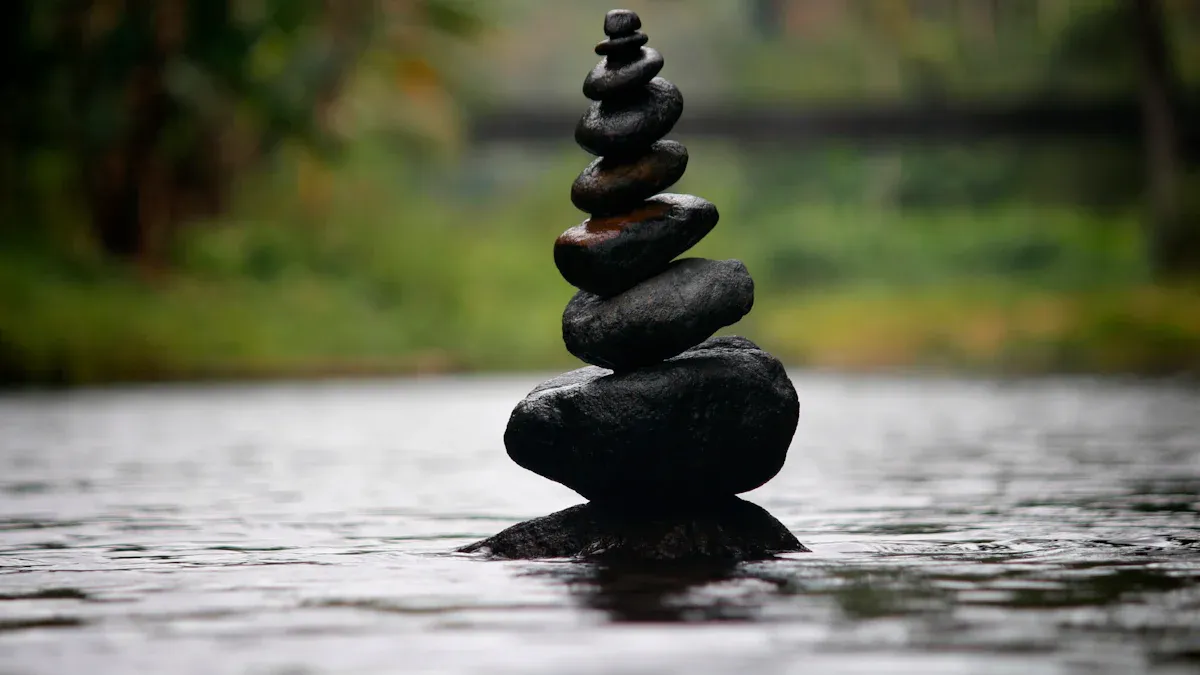
Earthing Techniques
You can use earthing, or grounding, to help your body and mind feel calm. Earthing means making direct contact with the earth, like walking barefoot on grass or soil. This simple act connects you to the natural energy of the ground. Many people say they feel more relaxed and peaceful after spending time barefoot outside.
Scientists have found that grounding can lower stress and anxiety. In animal studies, rats that used earthing mats showed less anxious behavior. Their brains also had lower levels of stress hormones. Some researchers believe that grounding gives your body tiny electrons from the earth. These electrons may help balance your body’s stress response.
You do not need special tools to try earthing. Here are some easy ways to start:
Walk barefoot on grass, sand, or dirt.
Sit with your hands touching the ground.
Lie down on the earth and feel its support.
Tip: Try earthing for just five minutes a day. Notice how your body feels before and after. You may feel lighter, calmer, or more at ease.
Nature as Teacher
Nature has always played a big role in Taoist wisdom. When you spend time outdoors, you learn from the world around you. Trees, rivers, and mountains all show you how to flow with change and stay strong. Taoism teaches you to live in harmony with nature. This helps you feel more peaceful and less stressed.
You can use nature as your teacher in many ways:
Watch how water moves around rocks. It does not fight, it flows.
Listen to birds and notice how they live in the moment.
Sit quietly under a tree and breathe deeply.
Taoist practices like tai chi and meditation often happen outside. These activities help you connect with the natural world. When you follow nature’s example, you learn to let go of worries and accept life as it comes.
Remember: Nature does not rush, but everything gets done. Let the outdoors remind you to slow down and enjoy each moment.
Balancing Activity and Rest
Listening to Your Body
Taoism teaches you to notice your body’s signals. Your body often tells you when it needs rest or when it wants to move. You might feel tired after a busy day or restless after sitting too long. Taoist wisdom says that both activity and rest are important for your well-being. You do not need to push yourself all the time. Instead, you can find a gentle rhythm that matches your needs.
Taoist principles encourage you to balance Yin (rest) and Yang (activity) for mental clarity and emotional stability.
Practices like mindful breathing, tai chi, and spending time in nature help you tune in to your body’s needs.
Taoism suggests that balance is not a fixed state. You can adjust your activity and rest as your needs change.
Simplifying your life helps reduce mental clutter and brings more calm.
Connecting with nature, even through a short walk or sitting outside, supports your mind and body.
You can listen to your body by checking in with yourself during the day. Ask, “Do I need a break?” or “Would a short walk help me feel better?” This simple habit helps you stay balanced and reduces stress.
Creating Routine
A steady routine helps you balance activity and rest. You can build small habits into your day that support your mental health. Many people find that routines make life feel more stable and less stressful.
Here are some routines that research supports for reducing anxiety:
Try progressive muscle relaxation. Tense and relax each muscle group to help your body unwind.
Use adult coloring books. Coloring patterns like mandalas gives your mind a restful break.
Practice deep breathing. Techniques like box breathing calm your nervous system.
Add gentle yoga to your day. Yoga lowers stress and helps you balance movement with rest.
You do not need to do everything at once. Start with one or two routines that feel good to you. Over time, these habits help you feel more peaceful and in tune with your natural rhythm.
Instant Relief Guide
Quick Steps for Anxiety
When anxiety shows up, you can use Taoist techniques to find calm quickly. These steps help you return to balance and peace.
Pause and Breathe: Sit down or stand still. Take a slow, deep breath. Let your belly rise as you breathe in. Breathe out gently. Repeat this three times. Mindful breathing helps your body relax and your mind slow down.
Notice and Accept: Pay attention to what you feel. Do not judge your feelings. Remind yourself that anxiety is a natural part of life. You do not need to fight it. Acceptance helps you let go of resistance.
Let Go and Flow: Imagine yourself floating on a gentle river. Let your thoughts and feelings drift by. Wu Wei, or effortless action, teaches you to move with life instead of against it.
Balance Your Energy: If you feel restless, try a simple movement like shaking out your hands or stretching. If you feel tired, sit quietly and rest. Balancing yin (rest) and yang (activity) helps you find the right energy for the moment.
Embrace Change: Remind yourself that feelings come and go. Change is part of life. When you accept this, you feel more peaceful and strong.
Tip: You can use these steps anywhere—at home, at school, or outside. You do not need special tools or a quiet room.
When to Use
You can use these instant relief steps whenever you notice anxiety rising. Try them before a test, during a busy day, or when you feel overwhelmed. These Taoist practices work best when you use them early, as soon as you feel stress building. You can also use them at night if your mind feels busy. Over time, these steps help you build a habit of calm and resilience. Remember, you do not need to wait for a big problem. Small moments of stress are a good time to practice too.
Remember: Every time you use these steps, you teach your mind and body how to return to peace. Practice often, and you will find it easier to handle anxiety in any situation.
You can use Taoism to guide your journey toward living a low-stress life. Try tai chi for movement and meditation for your mind. Tai chi brings calm and peace. Mindfulness and tai chi help you practice self-care. Start with tai chi or meditation. Tai chi teaches you to move with calm. You can feel peace with tai chi. Living a low-stress life grows with tai chi. Tai chi supports your calm. Meditation and tai chi help you find peace every day. Remember, progress is gentle. Explore tai chi, meditation, and mindfulness for a peaceful path.
FAQ
What is a Taoist soft mindset?
A Taoist soft mindset means you stay gentle with yourself. You accept your feelings and let them pass. You do not force things. You trust that calm will return, just like water finds its way.
Can Taoist techniques help with sudden anxiety?
Yes! You can use Taoist breathing or a quick mindfulness pause when anxiety appears. These simple steps help you feel calmer fast. You do not need special tools. Just pause, breathe, and notice your feelings.
How often should I practice Taoist stress relief?
You can practice every day. Even a few minutes helps. Try mindful breathing in the morning or tai chi after school. Small, regular steps work best. Over time, you will notice more peace.
Do I need to believe in Taoism to use these techniques?
No, you do not need to follow Taoism as a religion. Anyone can use these practices. They work for people of all backgrounds. You can enjoy the benefits by simply trying the exercises.
What if I forget to practice when I feel anxious?
That is okay! You can always start again. Each moment gives you a new chance. Be kind to yourself. Remember, progress comes with practice, not perfection.
